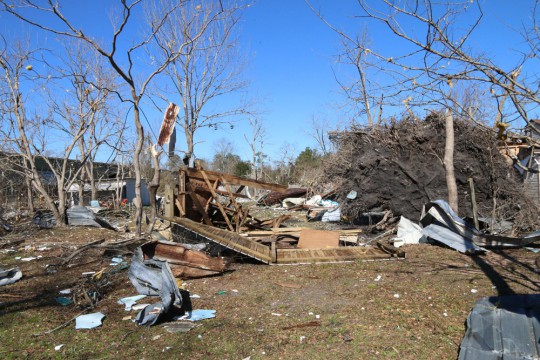FEMA Considering Change To Disaster Aid For States
August 11, 2016
States should back a proposed federal program that could initially have them take on more disaster recovery costs — but with the ability to lower the tab by investing in preparedness, Florida’s emergency director said Wednesday.
If the states don’t go along, they’ll risk Congress simply shifting more costs to the states without their input, Florida Division of Emergency Management Director Bryan Koon said.
The proposed change was floated this winter by the Federal Emergency Management Agency, which is under pressure from Congress to reduce how much of the cost Washington picks up for natural disasters.
Currently, if states hit a certain threshold for dollar losses, a federal-disaster declaration is issued and Washington picks up a portion of the cost. But the plan put forth tentatively by FEMA would set a “deductible,” amount similar to a car or homeowners’ insurance policy. Under that amount, state and local governments would be responsible for paying for disasters, and above it federal recovery spending could kick in.
But the plan would allow states to “buy down” their deductible, or get a lower threshold for federal help, by making investments in certain disaster-mitigation infrastructure improvements, such as stronger building codes or flood or wildfire prevention projects.
FEMA asked the states to comment on the idea earlier this year, and a number responded negatively, saying they feared they’d simply be hit with higher costs and additional administrative burdens and never see much benefit.
But speaking on a panel on emergency preparedness at the National Conference of State Legislatures on Wednesday in Chicago, Koon said he worries Congress is going to shift the burden anyway.
“I don’t think keeping the status quo is something that is going to happen,” Koon said. If the states reject the FEMA idea for a deductible method for paying for disasters, “we will leave ourselves at the whims of Congress, and I don’t think that’s going to come out in a way that will be beneficial for the states.”
The federal government currently determines when to grant disaster declarations based on a measure of how much the cost of the disaster is on a per-capita basis. But the per-capita dollar amount wasn’t adjusted for inflation for several years. A 2012 Department of Homeland Security report said that if the government had adjusted the per-capita metric for inflation, about a third of presidential disaster declarations in the interim wouldn’t have been granted.
“This is one area where we continually face criticism,” acknowledged FEMA Deputy Director for External Affairs Stephanie Tennyson, who was on the panel with Koon at Wednesday’s meeting.
Koon said he worries that Congress will unilaterally change the threshold for when states can get federal aid — but without the deductible reduction option — or change the current ratio of federal disaster funding, which right now has Washington pick up 75 percent, with state and local governments paying 25 percent.
Koon fears that Congress could seek to make the ratio or the threshold reflect those lost years of inflation adjustments all at once, something that could double or triple the amount of losses needed to be eligible for federal assistance in some states.
“That could be very difficult for many of our states,” Koon said. “In the bigger states, you’re looking at nine-digit losses before you’d be eligible.”
Disaster experts also said having the deductible buy-down would offer the added effect of a long-term lowering of disaster response costs, because presumably it would reduce damages, something FEMA’s Tennyson said was also a major goal of the proposed change.
And without some sort of prodding through the type of financial incentive being considered in the FEMA plan, states may not be likely to make those investments because the benefit wouldn’t come immediately. Also, states that are less disaster prone, don’t tend to plan for extremely rare events.
“People say, ‘It’s not going to happen to us,’ ” noted former Massachusetts Sen. Dick Moore, a Democrat who also served as associate director of FEMA during the Clinton administration.
Koon, tapped by Gov. Rick Scott in 2011 to lead the Florida Division of Emergency Management, said that in his role as the current president of the National Emergency Managers Association, he is trying to urge states to at least consider the proposal, though he understands the objections of some, particularly smaller states. They have said in comments to FEMA that they’re worried they’ll face added administrative burdens for proving they’ve made infrastructure improvements, and may not get the credits in the end, only to get saddled with higher costs up front when disaster strikes.
Koon also noted that Florida has already made many of the infrastructure improvements envisioned by the deductible system, and so he’s confident his state would be ahead of the game.
“Florida has some of the strongest building codes in the nation,” Koon said. “I think that we will be able to buy down a significant portion of what that deductible is.”
Koon also said going through the change might prevent Congress from acting if it appears the states are willing to try to figure out a way to help lower federal costs.
“This is going to take a while,” Koon said of the rule development process. “The likelihood is it’s going to be close to a decade before it is fully implemented. The good news is, you are less likely to see an action by Congress to unilaterally change the cost-share methodology. We’ll buy ourselves some time to work on this issue.”
by David Royse, The News Service of Florida
Pictured: Tornado damage in Century, which did not qualify under current rules, for FEMA assistance. NorthEscambia.com photo, click to enlarge.
Comments
One Response to “FEMA Considering Change To Disaster Aid For States”




Something about this, really bothers me and I can’t put my finger on it?